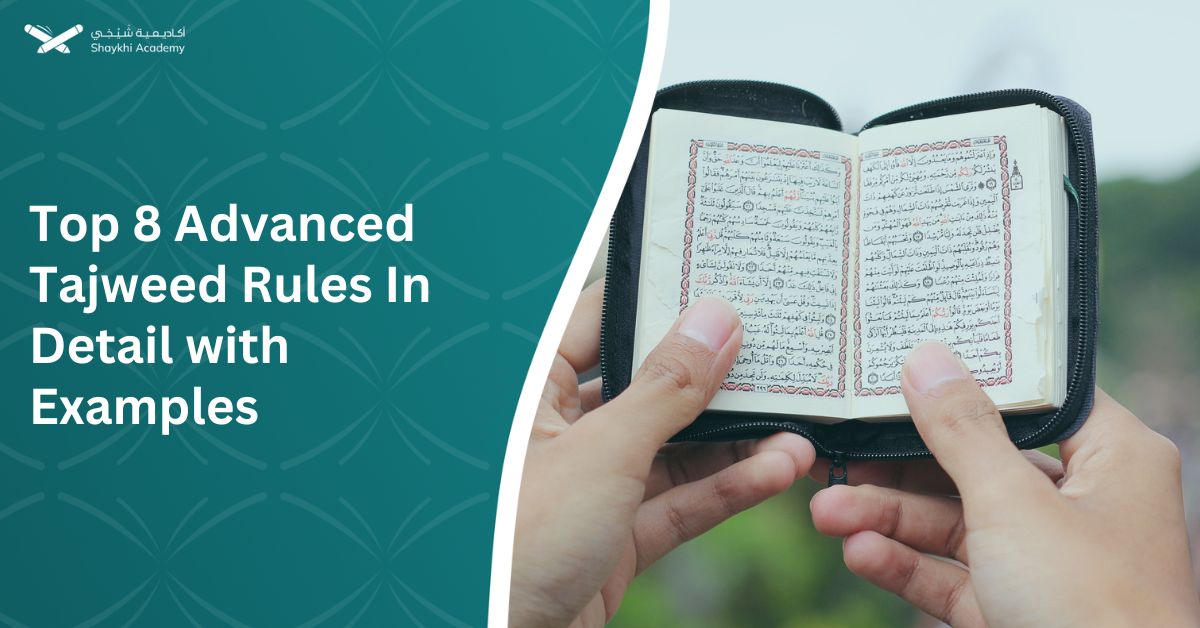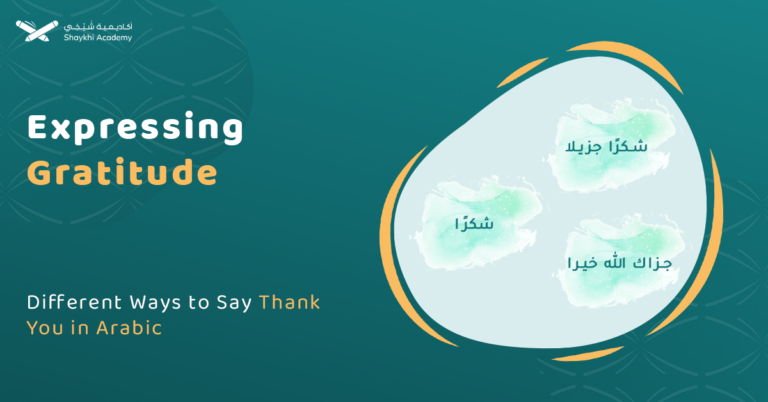Advanced Tajweed rules elevate Quranic recitation with refined techniques for perfect pronunciation, precise merging of letters, and nuanced emphasis. These rules ensure the recitation maintains the Quran’s linguistic beauty and divine eloquence.
Each rule of Tajweed has general, simple guidelines that are easy to understand and apply. However, for the same rule, there can also be advanced guidelines and detailed nuances that can be applied by those who have thoroughly understood the principles and practiced them well in their recitation of the Quran. Let’s explore some of these rules together:
What Are The Advanced Tajweed Rules?
Advanced Tajweed rules are specialized techniques in Quranic recitation that go beyond the basic principles, focusing on the finer aspects of pronunciation, articulation, and the subtleties of phonetic interactions between letters.
These rules are crucial for those who have mastered the foundational elements of Tajweed and wish to achieve a more precise and eloquent recitation. Advanced rules encompass complex cases such as the nuances in merging similar or dissimilar sounds (Idgham), the distinct ways of handling silent letters (Sukun), the various levels of letter emphasis (Tafkhim and Tarqeeq), and specific cases involving the Alif, Lam, and other critical letters in the Quran.
Understanding these advanced rules allows a reciter to maintain the linguistic purity and intended eloquence of the Quranic text, ensuring that each letter and sound is pronounced with the exactness prescribed by classical Arabic phonology.
Mastery of these rules not only enhances the aesthetic quality of recitation but also fulfills the religious and spiritual imperative of preserving the Quran’s divine articulation as revealed to Prophet Muhammad (PBUH).
This section will delve into the intricate rules of Tajweed, providing comprehensive details and examples to illustrate each rule’s application and significance.
1. The Rules of Idgham الإدغام
Idgham in Quranic recitation refers to merging one letter into another, resulting in a single, emphasized letter. It occurs due to similarity, proximity, or homogeneity between letters. There are two main types:
Major Idgham, involving two moving letters merging into one, and Minor Idgham, where a silent letter merges into a moving letter. Minor Idgham is further classified into assimilation of homogeneous, similar, and identical letters.
Execution of Minor Idgham can be complete, where the first letter is entirely assimilated, or incomplete, where some characteristics of the first letter remain. Understanding these rules ensures correct and proficient recitation, enhancing one’s connection to the Quran.
Causes of Idgham
Idgham occurs due to three main reasons:
A. Similarity (Tamathul):
When two letters are identical in name, form, articulation, and characteristics. Example: merging the letter “fa” into “fa” (ف) as in Verse:
“فَلاَ يُسْرِف فِّـي الْقَتْلِ إِنَّهُ كَانَ مَنْصُوراً” (fala yusrifil qatli) (Al-Isra 33)
B. Proximity (Taqarrub):
When two letters are close in articulation and characteristics. Example: merging “nun” into “lam” as in Verse:
“أَلا إِنَّهُمْ هُمُ الْمُفْسِدُونَ وَلَـكِن لاَّ يَشْعُرُونَ” (Wa lakila yash’oroun) (Al-Baqarah 12)
C. Homogeneity (Tajanus):
When two letters share the same articulation point but differ in characteristics. Example: merging “ta” into “dal” as in:
Verse:
“قَالَ قَدْ أُجِيبـَت دَّعْوَتُكُمَا” (qal qad ujeibattda’watukoma) (Yunus 89)
Types of Idgham
Idgham is classified into two main types:
A. Major Idgham (Idgham Kabir):
The merging of two moving letters so that they become a single emphasized letter. Examples include:
Word: “تَأْمَـنَّـا” (Ta’manna) from the verse: “قَالُواْ يَا أَبَانَا مَا لَكَ لاَ تَأْمَـنَّـا عَلَى يُوسُفَ وَإِنَّا لَهُ لَنَاصِحُونَ” (Yusuf 11)
Original form: تأمنُنَا (T’amanuna), the “nun” is merged into the following “nun.”
Word: “أَتُحَاجُّونِّـي” (Atuhajunny) from the verse: “قَالَ أَتُحَاجُّونِّـي فِي اللّهِ وَقَدْ هَدَانِ” (Al-An’am 80)
Original form: أتحاجونَنِي (Atuhajunany)
Word: “مَا مَكّـَنِّي” (Ma makanny) from the verse: “مَا مَكّـَنِّي فِيهِ رَبِّي” (Al-Kahf 95)
Original form: ما مكنَنِي (Ma makanany)
B. Minor Idgham (Idgham Saghir):
The merging of a silent letter into a moving letter, making them a single emphasized letter of the same kind as the second letter. Examples include:
Verse:
“فَمَا رَبِحَت تِّـجَارَتُهُمْ وَمَا كَانُواْ مُهْتَدِينَ” (fama rabihat tijaratuhum) (Al-Baqarah 16)
Types of Minor Idgham:
Minor Idgham can be divided into three types:
A. Assimilation of Homogeneous Letters (إدغام متجانسين):
Letters with the same articulation point but different characteristics:
Examples:
Dental letters: “ta” into “ta”, “ta” into “dal”, “dal” into “ta”
Tongue tip letters: “tha” into “dhal”, “dhal” into “tha”
Labial letters: “ba” into “meem”
Example: “تاء التأنيث الساكنة في الطاء” from the verse:
“وَدَّت طَّـآئِفَةٌ مِّنْ أَهْلِ الْكِتَابِ لَوْ يُضِلُّونَكُمْ” (Aal-e-Imran 69)
Read as: “ودطّائفة”
B. Assimilation of Similar Letters (إدغام متقاربين):
Letters close in articulation and characteristics:
Examples:
“Lam” into “ra”: “وَقُـل رَّبِّ زِدْنِي عِلْماً” (Taha 114)
“Nun” into “waw”, “ya”, “ra”, “meem”, and “lam”: “وَلاَ يَجِدْ لَهُ مِن دُونِ اللّهِ وَلِـيّاً وَلاَ نَصِيراً” (An-Nisa 123)
“Qaf” into “kaf”: “أَلَمْ نَخْـلُـقكُّـم مِّن مَّاء مَّهِينٍ” (Al-Mursalat 20)
“Lam” of the definite article into solar letters: “ط ث ص ر ت ض ذ ن د س ظ ز ش ل” as in: “اهدِنَــــا الصِّرَاطَ المُستَقِيمَ” (Al-Fatiha 6)
C. Assimilation of Identical Letters (إدغام متماثلين):
Letters identical in articulation and characteristics:
Examples:
“Ta” into “ta”: “فَمَا رَبِحَت تِّـجَارَتُهُمْ وَمَا كَانُواْ مُهْتَدِينَ” (Al-Baqarah 16)
“Dal” into “dal”: “وَقَـد دَّخَلُواْ بِالْكُفْرِ” (Al-Ma’ida 61)
“Kaf” into “kaf”: “أَيْنَمَا تَكُونُواْ يُدْرِككُّمُ الْمَوْتُ” (An-Nisa 78)
In the case of “meem” (Idgham Shafawi): “أَلَا يَظُنُّ أُولَئِكَ أَنَّهُم مَّبْعُوثُونَ” (Al-Mutaffifin 4)
Types of Minor Idgham Execution:
There are several types of Minor Idgham when Executing:
A. Complete Idgham (Idgham Kamil):
The merging of a letter into another both in articulation and characteristics, eliminating the first letter entirely:
Example: “قَالَ قَدْ أُجِيبـَت دَّعْوَتُكُمَا” (Yunus 89)
The “ta” is completely assimilated.
Example: “أُوْلَـئِكَ عَلَى هُدًى مِّن رَّبِّهِمْ” (Al-Baqarah 2)
“Nun” is completely assimilated into “ra.”
Note: Complete Idgham is indicated in the script by removing the sukoon sign from the assimilated letter and emphasizing the letter it merges into.
B. Incomplete Idgham (Idgham Naqis):
The merging of a letter into another in articulation but not completely in characteristics, leaving some of the first letter’s characteristics:
Examples:
“Nun” into “waw”: “مِنَ اللّهِ مِن وَاقٍ” (Ar-Ra’d 34)
The nasal sound of “nun” remains.
“Nun” into “ya”: “مَن يَـقُولُ” (Al-Baqarah 8)
“Ta” into “ta”: “لَئِن بَسَطتَ” (Al-Ma’ida 28)
Retains the emphatic quality of “ta.”
“Qaf” into “kaf”: “أَلَمْ نَخْـلُـقكُّـم” (Al-Mursalat 20)
The “qaf” does not have its characteristic emphatic sound.
This detailed exploration of Idgham in Quranic recitation provides both basic and advanced understanding, enabling correct and proficient recitation by adhering to the principles and recognizing the nuances of each rule.
2. The Rules Of Meeting Two Silent Letters (التقاء ساكنين):
In Quranic recitation with Tajweed, it is generally not permissible to combine two consecutive silent letters in the same word, except in specific cases, or when a word ends with a silent letter and the following word begins with another silent letter.
Therefore, specific rules have been established to address the meeting of two silent letters, whether within a single word or across two words, as follows:
A. Meeting Two Silent Letters in One Word:
It is permissible to combine two silent letters in one word in the following two cases:
1. The first of the two silent letters is a long or soft letter.
Examples: (seen) (الضّالِّين), (عَيْنْ) , (سِيْنْ) (aldaleen) .
2. The silence of the second letter is due to a stopping condition.
Example: (وَالْعَصْرْ) (Wa Al-Asr).
In these instances, the reader does not alter the pronunciation of the word.
B. Meeting Two Silent Letters Across Two Words:
Arabic grammar does not allow the combination of two silent letters across two words. If this occurs, it is resolved in one of two ways:
Dropping the First Silent Letter:
If the first silent letter is a long vowel, it is dropped in pronunciation.
Examples:
– ﴾اتَّقُوا اللهَ﴿ (Ittaquo Allah) becomes “اتَّقُ الله” (ittaqullah).
– ﴾اهدِنَا الصِّرَاطَ﴿ (Ihdinaa Sirat) becomes “اهْدِنَ الصِّرَاطَ” (Ihdinasirat).
Moving the First Silent Letter:
If the first silent letter is a consonant, it is moved by adding one of the three vowels (fatha, kasra, or damma).
If a word ends with a silent letter followed by a connecting hamza or another silent letter, the first silent letter is moved to avoid the meeting of two silent letters. The movement can be:
a. With Kasra (breaking):
This is the most common and is used to avoid the meeting of two silent letters.
Examples:
﴾لَمْ يَكُنِ اللهُ﴿ (Lam yakun allah) becomes “لَمْ يَكُنِِ اللَّهُ” (Lam yakuni allah).
﴾قُلِ الحَمْدُ لِلَّهِ﴿ (kul Alhamdulillah) becomes “قُلِ الحَمْدُ لِلَّه” (kuli Alhamdulillah).
b. With Damma (rounding – الضمة):
This occurs when the first silent letter is a meem (م) of the collective, connected to a pronoun, or when it is a waw (و) preceded by a fat-ha.
Examples:
﴾وَأَنتُمْ الأَعْلَوْنَ﴿ (Wa antum Al-A’aloun) becomes “وَأَنتُمُ الأعْلَوْن” (Wa antumu Al-A’aloun)..
c. With Fatha (opening):
Examples:
The preposition مِنْ when it precedes a word starting with “Al”:
Examples:
﴾مِنَ المُؤْمِنِينَ﴿(Min Al-mu’mineen) becomes “مِنَ المُؤْمِنِينَ” (Mina Al-mu’mineen).
3. The Levels of Tafkhim (Emphasis):
Tafkhim (emphasis) refers to the thickness that enters the sound of the letter, filling the mouth with its resonance. It has five levels:
A. Open with an Alif after it:
This is the highest level of emphasis.
Examples: (Taaifa) (قَالَ), (طَائِفَةٌ) (kaal).
B. Open without an Alif:
Example: (خَيْرٌ) (khayr).
C. With a Damma:
Example: (يَصُومُ) (yasoum).
D. Silent (Sakin):
Examples: (Fasber) (فَاصْبِرْ).
F. With a Kasra:
Examples:(keel) (صِدْقٍ), (قِيلَ) (sedq).
4. The Rules of Tarqeeq In Tajweed:
Most letters are pronounced lightly, except Lam, Ra, and Alif under certain conditions. Alif follows the preceding letter, Lam in “Allah” is emphasized after Fatha or Damma and light after Kasra, and Ra’s pronunciation varies.
A. Letters That Are Always Pronounced Lightly (Tarqiq):
Tarqiq letters the remaining letters of the alphabet after excluding the emphatic,except for the letters Lam (ل), Ra (ر), and Alif (ا) in some of their conditions.
B. Letters Sometimes Emphasized, Sometimes Light:
There are some letters that sometimes are emphasized, sometimes are light. Alif follows the preceding letter’s emphasis; Lam in “Allah” is emphasized after Fatha or Damma, light after Kasra; Ra varies with four cases of pronunciation.
Alif (ا):
The Alif follows the previous letter in emphasis or lightness.
Example: (Altaraqi) (صَادِقِينَ), (قَالَ) , (التَّرَاقِي) (sadiqin).
If the preceding letter is one of the light letters, then the Alif is light: (الْقِيَامَةِ).
Lam (ل):
he Lam in the word “Allah” is emphasized (مفخمة) if preceded by a Fatha or Damma:
Examples: (Abdullah) (ضَرَبَ اللهُ), (عَبْدُ اللهِ) (Darb Allahu).
If preceded by a Kasra, the Lam is light (مرققة):
Examples: (Bismillah) (بِاللهِ),(بِسْمِ اللهِ) (Billahi).
In other contexts, the Lam is always light.
Ra (ر):
– The Ra has four cases of pronunciation:
– Light only.
– Between light and emphatic, but light is preferred.
– Between light and emphatic, but emphatic is preferred.
– Emphatic only.
By following these guidelines, readers can ensure they pronounce Quranic verses correctly, preserving the beauty and precision of the language.
5. The Definite Article “Alif Lam” (الـ التعريف)
The definite article “Alif Lam” (الـ التعريف), also known as “Al” is a silent Lam preceded by an open Hamzat Wasl (همزة وصل) and followed by a noun. It is always an addition to the structure of the word, whether the word can be meaningful without it, such as in the word “الأرض” (the earth), or cannot be meaningful without it, such as in the word “الذين” (those).
Letters Following the Definite Article “Alif Lam”:
The definite article “Alif Lam” precedes all Arabic letters except for the three long vowels and the silent Noon (ن) and Meem (م), to avoid the meeting of two silent letters. It precedes twenty-eight letters of the Arabic alphabet, but this must occur in two separate words because “Alif Lam” is a word and the following letter must be the initial letter of the next word.
6. The Rules Of Laam Shamsiya And Laam Qamariyah:
Two Cases of the Definite Article “Alif Lam” with the Following Letters The definite article “Alif Lam” has two cases when it precedes the twenty-eight letters:
A. The Qamariyah Lam (Moon Lam) (اللام القمرية)
Laam Qamariyah applies to fourteen letters: أ, ب, غ, ح, ج, ك, و, خ, ف, ع, ق, ي, م, ه.
When one of these letters follows the definite article, the Lam must be clearly pronounced (ظهر قمرياً), thus it is called Qamariyah Lam.
Examples:
أ”: الأَنْعام”
ك”: الكتاب”
ق”: القوي”
The rule here is clear pronunciation, called “Idhar,” due to the separation between the Lam and the majority of these letters in terms of articulation points and characteristics.
B. Shamsiyah (Sun) Lam (اللام الشمسية):
The Shamsiyah Lam applies to the remaining fourteen letters: ط, ث, ص, ر, ت, ض, ذ, ن, د, س, ظ, ز, ش, ل.
When one of these letters follows the definite article, the Lam must be merged into the following letter (إدغام شمسي), hence it is called Shamsiyah Lam.
Examples:
ط: “الطارق”
ض: “الضالين”
ظ: “الظانين”
The rule here is merging, called “Idgham,” due to the similarity between the Lam and most of these letters in terms of articulation points and characteristics.
7. Establishing and Omitting the Letters of Madd (Prolongation)
The Establishment and Omission of the Letters of Madd (Prolongation – إثبات حروف المد وحذفها) are characteristics of the Uthmani script (الرسم العثماني) that must be followed according to Sharia. A reader must know which letters are established and which are omitted in the script to pause appropriately on what is established and omit what is omitted, as pausing aligns with the script.
If a word ends with one of the three letters of Madd (Alif, Ya, or Waw), the pause should reflect the written form:
– If the letter is established both in connection and in the script, the pause should maintain this establishment:
Example: قالا رَبَّنا (Qalaa Rabbanaa), إِنِّي مَعَكُمْ (Inni Ma’akum), قالُوا خَيْراً (Qaaloo Khayran)
– If the letter is omitted in both connection and script, the pause should reflect this omission:
Example: وَلَمْ يَخْشَ إِلَّا اللَّهَ (Wa Lam Yakhsha Illa Allah), فِيمَ أَنْتَ (Feema Anta), وَمِنْ آياتِهِ الْجَوارِ (Wa Min Aayaatihi Aljawari), ادْعُ إِلَى سَبِيلِ رَبِّكَ (Ud’u Ilaa Sabeeli Rabbika)
– If the letter is established in the script but not in connection, the pause should reflect the script’s establishment:
Example: الظُّنُونَا (Althunoonaa) in Al-Ahzab, نُنْجِي الْمُؤْمِنِينَ (Nunjii Almu’miniin) in Al-Anbiyaa, إِنَّهُ هُوَ (Innahu Huwa)
There are some Special Cases for the above rules:
A. Alif (أ) Establishment and Omission:
The Alif is maintained during pauses if it is omitted in connection to avoid two silent letters meeting, regardless of whether it is part of the word’s root or not:
Examples: عَنْ تِلْكُمَا الشَّجَرَةِ (An Tilkuma Alshajarati), كِلْتَا الْجَنَّتَيْنِ (Kilta Aljannatayn), وَقَالَا الْحَمْدُ لِلَّهِ (Wa Qalaa Alhamdu Lillah)
Specific cases where Alif is omitted in pause due to the script:
Example: أيها المؤمنون (Ya Ayyuha Almuminoon) except in: أَيُّهَ الثَّقَلانِ (Ayya Althaqalain) in Al-Rahman
B. Ya (ي) Establishment and Omission:
The Ya is maintained during pauses if it is omitted in connection to avoid two silent letters meeting:
Examples: حاضِرِي الْمَسْجِدِ الْحَرَامِ (Hadhiri Almasjid Alharaami), مُحِلِّي الصَّيْدِ (Muhillee Alssaydi), غَيْرُ مُعْجِزِي اللَّهِ (Ghayru Mu’jizee Allah)
C. Waw (و) Establishment and Omission:
The Waw is maintained during pauses if it is omitted in connection to avoid two silent letters meeting:
Examples: يَمْحُوا اللَّهُ مَا يَشَاءُ (Yamhu Allahu Ma Yashaa), جَابُوا الصَّخْرَ (Jaaboo Alssakhr)
Specific cases where Waw is omitted in pause due to the script:
Example: وَيَدْعُ الْإِنْسَانُ (Wa Yad’u Alinsaanu) in Al-Isra
8. Types of Alif (ا) in the Quran:
The letter Alif is an important letter in the Arabic alphabet with many uses. However, in the Quran, Alif appears in several forms beyond the Hamzat al-Qat’ and Hamzat al-Wasl:
A- Alif with a Small Circle Above:
This Alif is written but not pronounced and is marked with a small circle above it (ه). It is retained in writing but omitted in pronunciation when stopping and joining. Examples include: (ثَمُودَاْ) and it appears in four places in the Quran: Hud 68, Al-Furqan 68, Al-Ankabut 38, An-Najm 51.
B- Madd Alif (الألف المدية):
This Alif is retained in both stopping and joining when followed by a vowel, such as: (فَلَمّا رَأَى القَمَرَ بازِغًا قالَ هـذا رَبّي). However, if followed by a silent letter, the Alif is omitted to prevent the meeting of two silent letters, such as: (فَلَمّا ذاقَا الشَّجَرَةَ).
C- Alif in Definite and Indefinite Nouns (ألف الاسم المقصور المنون):
This Alif in the noun is represented by an Alif written as a Yaa, and when it has the Tanween of Fatha, if paused upon, the Tanween is dropped, and the Alif is retained, such as: (وَأَجَلٌ مُّسَمًّى عِندَهُ).
D- Dagger Alif (الألف الخنجرية):
This Alif is represented in the Quranic script by a small Alif and is ruled to be omitted in writing but pronounced, extending naturally by two Harakaat, such as: (أَهَـكَذَا), (الرَّحْمَـٰنِ), and other words.
These advanced rulings enhance the precision and beauty of Quranic recitation, ensuring the proper articulation and pronunciation as revealed.
Learn Tajweed With Shaykhi Academy
A Muslim loves to excel in everything, and Tajweed means excellence. There is nothing better than perfecting the recitation of the words of Allah, the Almighty. With Sheikh Academy, you can learn memorization, recitation, and Tajweed to elevate yourself to the highest ranks by the will of Allah.
At Sheikh Academy, we offer a comprehensive set of lessons suitable for all age groups and levels. Whether you are a beginner in reading the Quran or seeking an accredited certification in memorization, recitation, or Tajweed, you will find all these lessons and more at Sheikh Academy with skilled and proficient teachers.
We ask Allah, the Almighty, to teach us what benefits us and to benefit us with what He has taught us. He is capable of all things.
Why Choose Shaykhi Academy?
- Connect with highly qualified native tutors.
- Flexible scheduling to suit your busy lifestyle.
- Affordable classes tailored for all levels.
- Accessible from anywhere around the globe.
Discover Our Range of Courses:
- Arabic Noorani Qaida: Lay a solid foundation for Quranic studies.
- Online Quran Classes for Kids: Engaging lessons for lifelong learning.
- Tajweed Rules for Kids: Learn to recite with confidence.
- Quran Hifz for Kids: Step-by-step guidance to memorize the Quran.
- Quran for Adults: Introduce yourself to Quran reading and Tajweed rules.
- Online Arabic Courses: Master the language of the Quran.
- Islamic Studies: A wide range of topics related to Islam, including theology, law, Quranic studies, Hadith.
Don’t Miss Out on Your Chance to Excel!Whether you’re a beginner or seeking advanced knowledge, Shaykhi Academy can guide you! Book your free trial now

Conclusion
Advanced rules of Tajweed are more detailed and in-depth in understanding and improving the recitation of the Quran.
They take us to a deep understanding of the rules with detailed explanations, such as the rules of stopping and starting and their places in the Quran, the rules of Alif in Quranic words, the details of Idgham (assimilation) and its causes and types, the details of Ikhfa (concealment) and its pronunciation methods and reasons for naming, and the rules of the solar and lunar Lam which we explained in this article.
These advanced rules also cover various rulings and their levels, such as the levels of thickening and thinning, and much more in the advanced rules of Tajweed. We pray to Allah that we and you become among the people of the Quran, who are Allah’s people and His special ones.


















































